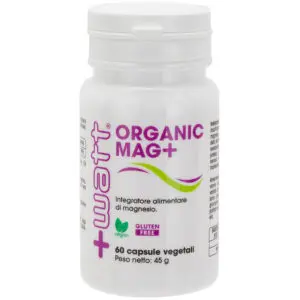Magnesium plays a primary role in the functions of cells and acts as a regulator of many vital functions of the organism.
Unfortunately, the current western diet and the increased industrial refining of food has led to a progressive reduction in the amount of magnesium and other minerals in food, with the risk of an insufficient intake of the recommended daily magnesium dose (Reference Nutritional Values = 375 mg of magnesium).
It is advisable, in case of inadequate intake from the foods of this precious micronutrient, to support the diet with food supplementation approach in order to reach the daily requirement.
It should be stressed, however, that food supplementation must be made (as always) in a reasoned manner. For example, one of the most common mistake is to consider only the amount of the nutrient brought by the specific tablet or powder without considering how effectively our body absorbs that nutrient.
The body’s ability to assimilate a certain nutrient is defined as bioavailability, i.e. how much the body is able to absorb it in the digestive system and therefore to use it effectively for its physiological functions.
Bioavailability (to be considered both for what concerns nutrition and food supplementation) may depend on many factors, such as age, sex, cooking, presence of other nutrients and / or drugs, characteristics of intestinal microflora, genetic factors, nutritional status of the organism.
In particular, the presence of other nutrients is essential to evaluate the bioavailability of mineral salts.
Let’s take the case of magnesium as an example.
Magnesium is ALWAYS associated with other nutrients, usually in the form of magnesium salts. It is a weak bond between magnesium and another molecule. In the technical chemical language, this weak bond is named ‘ionic bond’, but the concept can be better understood by imaging that magnesium and the other molecule are held by hand and enter the intestinal tract together. The molecule that accompanies the magnesium can be a good travel companion, which helps magnesium itself to be effectively absorbed into the body, or a bad travel companion, limiting its bioavailability.
Given the nutritional and therapeutic interest of magnesium, scientific research has carried out numerous studies on what are the most effective ‘accompanying’ magnesium molecules.
There are different types of magnesium salts, which can be divided into two categories: organic magnesium salts and inorganic magnesium.
Organic magnesium salts are those in which magnesium is accompanied by a molecule that contains carbon and which is present in living things, such as magnesium citrate, magnesium lactate, magnesium pidolate, magnesium gluconate, etc.
Inorganic magnesium forms are those associated with elements other than carbon, such as magnesium oxide, magnesium hydroxide, magnesium sulphate, and that are more frequently found in rocks and in the soil.
What the research has clearly shown is that inorganic magnesium is the ones with the lowest bioavailability. This is due, at least in part to their low water solubility (Bohn, Curr Nutr Food Sci, 2008), namely their lack of ability to dissolve in water, a prerequisite to be absorbed in the lumen of the intestine. In other words, if you take an inorganic form of magnesium, only a small part is absorbed and enters the blood. The unabsorbed magnesium remains in the lumen of the intestine, with possible laxative effects.
Likewise, also magnesium carbonate, although containing carbon, displays a very low solubility (Bohn, Curr Nutr Food Sci, 2008) and therefore an extremely low absorption (Ranade & Somberg, Am J Ther, 2001).
On the other hand, organic magnesium salts are those with the highest absorption (Firoz & Graber, Magnes Res, 2001, Ranade & Somberg, Am J Ther, 2001, Bohn, Curr Nutr Food Sci, 2008). Far from understanding completely which is the most bioavailable magnesium form, it is however underlined by the scientific community that the intake of an organic magnesium salt such as magnesium citrate, magnesium lactate, magnesium pidolate or magnesium gluconate allows a high absorption of magnesium in the blood and very low risks of laxative effects.
In conclusion, the magnesium example emphasizes that in nutrition and in food supplementation it is not only essential to look carefully at the quality and safety of the nutrients that are assumed, but also it is very important to consider how much of that nutrient the body actually adsorbs, namely its bioavailability.
+Watt Advice
Recommended intake: take Tri mag, 2 tablets a day, with a sip of water.




